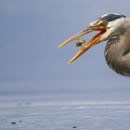About Us
Established in 1983, Bandon Marsh NWR is located along the picturesque southern Oregon coast near the mouth of the Coquille River and the city of Bandon. Its invertebrate-rich mudflats fuel the migration of tens of thousands of shorebirds every spring and fall, making it an important stopover site along the Pacific Flyway. Young salmon and trout find sanctuary in the estuary's steep-banked tidal channels and anchored driftwood.
The freshwater and intertidal marshes, forested wetlands, grasslands, and upland forest of Bandon Marsh NWR are the ancestral home of the Coquille Indian Tribe, whose members reside in the area and continue to use and enjoy the many resources of the Refuge.
Our Mission
Bandon Marsh National Wildlife Refuge protects the largest remaining tidal salt marsh salt marsh
Salt marshes are found in tidal areas near the coast, where freshwater mixes with saltwater.
Learn more about salt marsh within the Coquille River estuary. Located near the mouth of the Coquille River, it is an oasis for migrating shorebirds, waterfowl, and threatened and endangered species such as Coho Salmon and Western Snowy Plover.
Our History
Established in 1983 and expanded several times since, Bandon Marsh NWR now encompasses 889 acres and is composed of two major marsh areas: Bandon Marsh and Ni-les’tun Marsh. Habitat restoration projects on the Ni-les’tun Marsh were completed in 2014 and benefit fish and wildlife species and protect cultural resources from development. In addition to providing habitat for wildlife, tidal marshes sequester atmospheric carbon in plant tissues and buffer coastlines against storm surges.
Bandon Marsh, the first area designated as part of this refuge,protects a large tract of salt marsh salt marsh
Salt marshes are found in tidal areas near the coast, where freshwater mixes with saltwater.
Learn more about salt marsh within the Coquille River estuary, second in size only to the Ni-les'tun Marsh. Major habitats include undisturbed salt marsh, mudflat, and Sitka Spruce/Red Alder riverbank communities. These provide resting and feeding areas for migratory waterfowl, shorebirds, wading birds, neotropical migrants, and raptors.
The lower Coquille River estuary provides important habitat for juvenile and adult forms of anadromous fish species, including Coho and Chinook salmon, steelhead, and Cutthroat Trout.
The Ni-les'tun Marsh of Bandon Marsh NWR was named by the Coquille Indian Tribe. Ni-les'tun means "small fish dam in the river", referring to the numerous fish weirs located on and adjacent to the site, which were used by ancestral Coquille for capturing salmon and other estuarine species.
Most of the land in the Ni-les'tun Unit was formerly diked lowland pasture. In 2011, thanks to efforts by Refuge staff and their partners, dikes were lowered and tide gates were removed to restore over 400 acres of tide marsh, making it the largest tide marsh restoration project in Oregon. Other habitats of the Ni-les'tun Unit include intertidal marsh, forested wetlands, grasslands, and upland forest.
Since the restoration of Ni-les'tun Marsh, the refuge has focused on studying the impacts and progression of the restoration through time and developing other areas of the refuge to benefit wildlife and the public. For more information about ongoing refuge management, visit the Initiatives page.
Other Facilities in this Complex
Bandon Marsh National Wildlife Refuge is managed as one of six Refuges in the Oregon Coast National Wildlife Refuge Complex. See below for the other five Refuges and experience them all.
Refuge Headquarters:
Oregon Coast National Wildlife Refuge Complex
2127 SE Marine Science Drive
Newport, OR 97365
541-867-4550
oregoncoast@fws.gov
What is a Refuge Complex?
A National Wildlife Refuge Complex is a group of two or more refuges, wildlife management areas or other refuge conservation areas that are managed from one central office. Refuges are grouped into a complex because they occur in a similar ecological region, such as a watershed or specific habitat type, and have a related purpose and management needs.
The Oregon Coast National Wildlife Refuge Complex is managed from our headquarters in Newport, Oregon. The office located at Bandon Marsh NWR serves as a south-coast field office.





